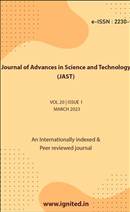The Impact of Artificial Intelligence (AI) on Society
DOI:
https://doi.org/10.29070/rx6mcp48Keywords:
artificial intelligence, society, impact, fourth industrial revolution, day-to-day activities, social interactions, understanding, progress, benefits, intelligent behaviourAbstract
The advent of artificial intelligence (AI), often known as the fourth industrial revolution (IR 4.0),will affect not just our day-to-day activities and social interactions, but also our understanding of who weare. Artificial intelligence, however, has a profound effect on the way we go about our daily lives andconnect with one another. Keep an eye on the progress of AI to ensure that everyone can reap the benefitsof this new kind of intelligence. This idea is linked to the concept that AI should display intelligentbehaviour. Prior to this, only humans were allowed there. Artificial intelligence (AI) can act autonomously ina variety of contexts and solve complex issues without human intervention. The way people think about thedevelopment of artificial intelligence has changed drastically as a result. There are many facets of modernlife in which artificial intelligence is rapidly progressing. There are many potential applications for artificialintelligence, including healthcare and the creation of game-changing technology like autonomous cars.There have been good and bad results from AI's entrance into society. The major purpose of this studyis to examine the effects of AI on society and the difficulties AI faces.Downloads
References
Anderson S., Slough S. (2015). Digital Delight or Digital Doldrum: A Study of Graphical Representation in Digital Science Textbooks. Semantic Scholar Resource (26)2: pp. 654-675.
Nicoletti G. (2018). Digital Technology Diffusion: A Matter of Capabilities, Incentives or both? Semantic Scholar Review (12)3: pp. 264-276
Chandani A., et al. (2016). Employee Engagement: A Review Paper on Factors Affecting Employee Engagement. Indian Journal of Science and Technology (15)9: pp. 12-18.
Adams S., Arin R. (2015). Mapping the Landscaper of Human-Level Artificial Intelligence. Artificial Intelligence Magazine Insights (33)2: pp. 25–42
Drucker S. (2019). Generalizability modeling of the foundations of customer Delight. Journal of Modelling in Management (2)1: pp. 18-32
Goldfarb A. (2017). What to expect from Artificial Intelligence in Industrial Transformation? MIT Sloan Management Review (58)3: pp. 11-23.
Byrnes N. (2016). Artificial Intelligence Hits the Mainstream of Industrial Market Place. MIT Technology Review (12)2: pp. 231-239.
Prasad J. (2018). The Antecedents and Consequents of User Perceptions in Information Technology Adoption. Journal of Decision Support Systems (22)1: pp. 15-29.
Wayne D. (2017). Prediction Using Logistic Regression for Measuring the Pathological Results on the Health Technologies. IEEE Journal of Quantum Electronics (32)6: Pp. 312-318.
Agrawal A. (2015). VQA: Visual Question Answering on Artificial Intelligence in Medical Innovations. In the Proceedings of the IEEE International Conference on Computer Vision (23)5: pp. 2425–2433.
Kennedy J C. (2020). Customer Engagement: Opportunities and Challenges for Organizations. Journal of Service Research 14(3): pp. 272-274.
Bolton R N., Kennedy J C. (2018). Challenges Facing Development of Intelligent Systems: Considering Together Digital, Physical and Social Realms. Journal of Service Management (29)5: pp.776-808






